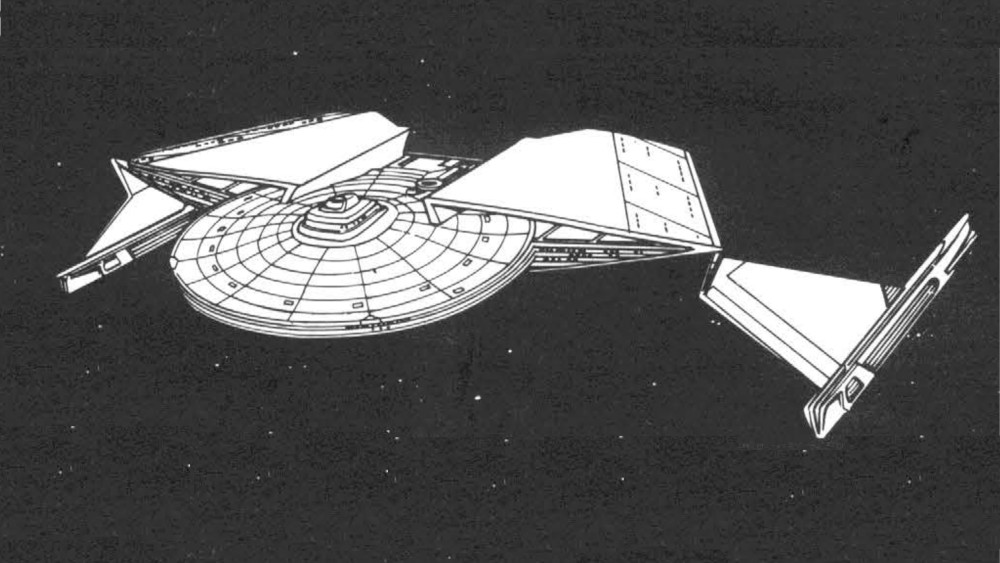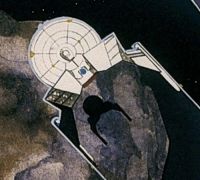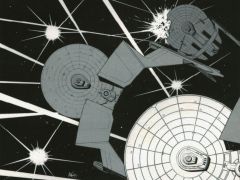Difference between revisions of "Chandley class (FASA)"
m |
m |
||
| (9 intermediate revisions by the same user not shown) | |||
| Line 1: | Line 1: | ||
| − | {{DISPLAYTITLE:''Chandley'' class}} | + | {{DISPLAYTITLE:''Chandley'' class (FASA)}} |
| − | {{ | + | {{ImageInfoBox2|name=''Chandley'' class|file=chandley_class-fasa-2302.jpg|caption=''Chandley'' class ([[Star Trek: The Role Playing Game (FASA)|FASA]] [[Federation Ship Recognition Manual (FASA-2302)|2302]])}} |
| − | + | {{TableRow|title=Commissioned|data=[[Reference Stardate|RSD]] [[FASA Chronology: 2216#December|2/1612 (December 2216)]]}} | |
| − | + | {{TableRow|title=Advertising|data={{AmazonLinkFASA2302E2}}}} | |
| − | {{ | + | |}</div> |
| − | + | {{BannerFASA}} | |
| − | |||
| − | |||
| − | |||
| − | |||
| − | |||
| − | |||
| − | |||
| − | |||
| − | |||
| − | |||
| − | |||
| − | {{ | ||
After the conclusion of the [[Four Years War]], [[Star Fleet Command]] initiated the Strategic Forces Survey; the results of the study influenced plans ever since. One weakness identified was the need for combat vessels carrying boarding parties or prize crews to quickly deliver decisive blows against a retreating or routed enemy. Star Fleet ships did not routinely carry [[Star Fleet Marines|Marine]] assault teams, and therefore were unable to board and capture enemy vessels or outposts. In many operations, Star Fleet vessels were held back so that their combined boarding groups could take control of disabled enemy vessels or outposts; this caused lengthy delays in follow-up operations and allowed the enemy time to recover. To take enemy outposts, assault ships were called in, frequently a poor choice because they were too slow, vulnerable, and usually carried too many troops for small operations. To address this, Star Fleet began to develop frigates designed to carry Marines trained to board hostile vessels and complexes. The most impressive of these frigates was the ''Chandley'' class.<ref name="FASA2302E2"/> | After the conclusion of the [[Four Years War]], [[Star Fleet Command]] initiated the Strategic Forces Survey; the results of the study influenced plans ever since. One weakness identified was the need for combat vessels carrying boarding parties or prize crews to quickly deliver decisive blows against a retreating or routed enemy. Star Fleet ships did not routinely carry [[Star Fleet Marines|Marine]] assault teams, and therefore were unable to board and capture enemy vessels or outposts. In many operations, Star Fleet vessels were held back so that their combined boarding groups could take control of disabled enemy vessels or outposts; this caused lengthy delays in follow-up operations and allowed the enemy time to recover. To take enemy outposts, assault ships were called in, frequently a poor choice because they were too slow, vulnerable, and usually carried too many troops for small operations. To address this, Star Fleet began to develop frigates designed to carry Marines trained to board hostile vessels and complexes. The most impressive of these frigates was the ''Chandley'' class.<ref name="FASA2302E2"/> | ||
| − | |||
The ''Chandley'' class was designed primarily as a fighting vessel. The fore and aft [[photon torpedo|torpedoes]], along with the powerful [[phaser|phasers]], made it a formidable foe, and if the opponent lowered [[shields]], either voluntarily or involuntarily, the ''Chandley'' was ready. The class normally carried a Marine company for use as reinforcements in boarding parties or for landing parties planetside.<ref name="FASA2302E1"/> | The ''Chandley'' class was designed primarily as a fighting vessel. The fore and aft [[photon torpedo|torpedoes]], along with the powerful [[phaser|phasers]], made it a formidable foe, and if the opponent lowered [[shields]], either voluntarily or involuntarily, the ''Chandley'' was ready. The class normally carried a Marine company for use as reinforcements in boarding parties or for landing parties planetside.<ref name="FASA2302E1"/> | ||
| Line 31: | Line 18: | ||
Of the 184 ''Chandley'' class frigates built by [[FASA Chronology: 2223#June|2/2306 (June 2223)]], 63 Mark Is, 64 Mark IIIs, and 47 Mark IVs remained in active service. Two Mark Is had been transferred to [[Star Fleet Command#Training Command|Star Fleet Training Command]]; four Mark Is and one Mark IV had been destroyed; one Mark I was listed as missing; one Mark I had been scrapped; and one Mark I had been sold to the private sector. The ''Chandley'' class was produced at the shipyards of [[Utopia Planitia shipyard|Mars]], [[Saturn]], and [[Andor (FASA)|Andor]] at a rate of four Mark Is, ten Mark IIIs, and 14 Mark IVs per year.<ref name="FASA2302E2"/> | Of the 184 ''Chandley'' class frigates built by [[FASA Chronology: 2223#June|2/2306 (June 2223)]], 63 Mark Is, 64 Mark IIIs, and 47 Mark IVs remained in active service. Two Mark Is had been transferred to [[Star Fleet Command#Training Command|Star Fleet Training Command]]; four Mark Is and one Mark IV had been destroyed; one Mark I was listed as missing; one Mark I had been scrapped; and one Mark I had been sold to the private sector. The ''Chandley'' class was produced at the shipyards of [[Utopia Planitia shipyard|Mars]], [[Saturn]], and [[Andor (FASA)|Andor]] at a rate of four Mark Is, ten Mark IIIs, and 14 Mark IVs per year.<ref name="FASA2302E2"/> | ||
| − | {{ | + | {{InfoBox|boxwidth=50%|float=left|name=Specifications<ref name="FASA2302E2"/>}} |
| − | |||
{| | {| | ||
! style="width:25%;" | | ! style="width:25%;" | | ||
| Line 40: | Line 26: | ||
|- | |- | ||
| class="HeaderRow ButtonLeft" style="vertical-align:top;text-align:right;" | Date entered service | | class="HeaderRow ButtonLeft" style="vertical-align:top;text-align:right;" | Date entered service | ||
| − | | style="text-align:left;" | [[FASA Chronology: 2216#December|2/1612]] | + | | style="text-align:left;" | [[FASA Chronology: 2216#December|2/1612]] |
| − | | style="text-align:left;" | [[FASA Chronology: 2219#February|2/1902]] | + | | style="text-align:left;" | [[FASA Chronology: 2219#February|2/1902]] |
| − | | style="text-align:left;" | [[FASA Chronology: 2219#December|2/1912]] | + | | style="text-align:left;" | [[FASA Chronology: 2219#December|2/1912]] |
|- | |- | ||
| class="HeaderRow ButtonLeft" style="vertical-align:top;text-align:right;" | Number Constructed | | class="HeaderRow ButtonLeft" style="vertical-align:top;text-align:right;" | Number Constructed | ||
| Line 79: | Line 65: | ||
| style="vertical-align:top;text-align:left;" | M-6A | | style="vertical-align:top;text-align:left;" | M-6A | ||
|- | |- | ||
| − | | class="HeaderRow ButtonLeft" style="vertical-align:top;text-align:right;" | [[ | + | | class="HeaderRow ButtonLeft" style="vertical-align:top;text-align:right;" | [[transporter|Transporters]] |
| − | | style="vertical-align:top;text-align:left;" | | + | | style="vertical-align:top;text-align:left;" | {{bullet}} 6-Person: 8<br/>{{bullet}} 22-Person: 4<br/>{{bullet}} Cargo: 2 |
| − | + | | style="vertical-align:top;text-align:left;" | {{bullet}} 6-Person: 8<br/>{{bullet}} 22-Person: 4<br/>{{bullet}} Cargo: 2 | |
| − | + | | style="vertical-align:top;text-align:left;" | {{bullet}} 6-Person: 8<br/>{{bullet}} 22-Person: 4<br/>{{bullet}} Cargo: 2 | |
| − | + | ||
| − | |||
| − | | style="vertical-align:top;text-align:left;" | | ||
| − | |||
| − | |||
| − | |||
| − | |||
| − | |||
| − | | style="vertical-align:top;text-align:left;" | | ||
| − | |||
|- | |- | ||
| class="HeaderRow ButtonLeft" style="vertical-align:top;text-align:right;" | Crew | | class="HeaderRow ButtonLeft" style="vertical-align:top;text-align:right;" | Crew | ||
| Line 114: | Line 91: | ||
| style="vertical-align:top;text-align:left;" | 12 | | style="vertical-align:top;text-align:left;" | 12 | ||
|- | |- | ||
| − | | class="HeaderRow ButtonLeft" style="vertical-align:top;text-align:right;" | | + | | class="HeaderRow ButtonLeft" style="vertical-align:top;text-align:right;" | Velocity |
| − | | style="vertical-align:top;text-align:left;" | Warp 7 | + | | style="vertical-align:top;text-align:left;" | {{bullet}} Cruising: Warp 7<br/>{{bullet}} Emergency: Warp 9 |
| − | + | | style="vertical-align:top;text-align:left;" | {{bullet}} Cruising: Warp 7<br/>{{bullet}} Emergency: Warp 9 | |
| − | | style="vertical-align:top;text-align:left;" | Warp 7 | + | | style="vertical-align:top;text-align:left;" | {{bullet}} Cruising: Warp 7<br/>{{bullet}} Emergency: Warp 9 |
| − | |||
| − | |||
| − | |||
| − | | style="vertical-align:top;text-align:left;" | Warp | ||
| − | |||
| − | |||
| − | |||
| − | |||
| − | |||
| − | |||
|- | |- | ||
| − | | style="vertical-align:top;text-align:left;" | 4 [[photon torpedo|torpedo]] tubes | + | | class="HeaderRow ButtonLeft" style="vertical-align:top;text-align:right;" | Weapons |
| − | | style="vertical-align:top;text-align:left;" | 4 [[photon torpedo|torpedo]] tubes | + | | style="vertical-align:top;text-align:left;" | {{bullet}} 6 FH-11 [[phaser|Phasers]] in 3 banks<br/>{{bullet}} 4 [[photon torpedo|torpedo]] tubes |
| − | | style="vertical-align:top;text-align:left;" | 4 [[photon torpedo|torpedo]] tubes | + | | style="vertical-align:top;text-align:left;" | {{bullet}} 6 FH-11 [[phaser|Phasers]] in 3 banks<br/>{{bullet}} 4 [[photon torpedo|torpedo]] tubes |
| + | | style="vertical-align:top;text-align:left;" | {{bullet}} 6 FH-11 [[phaser|Phasers]] in 3 banks<br/>{{bullet}} 4 [[photon torpedo|torpedo]] tubes | ||
|} | |} | ||
</div> | </div> | ||
| + | {{clear}} | ||
| + | ==Image Gallery== | ||
| + | <gallery mode="packed"> | ||
| + | chandley_class-fasa-2217.jpg|''Chandley'' class ({{FASA2217}}) | ||
| + | chandley_class-fasa2302e1.jpg|''Chandley'' class ({{FASA2302E1}}) | ||
| + | </gallery> | ||
{{ClassChandley|width=45%}} | {{ClassChandley|width=45%}} | ||
{{References}} | {{References}} | ||
| Line 144: | Line 118: | ||
[[Category:Ship Classes]] | [[Category:Ship Classes]] | ||
[[Category:Starfleet Vessels]] | [[Category:Starfleet Vessels]] | ||
| − | + | {{CategoriesFASA|name=Chandley class}} | |
| − | |||
| − | |||
| − | |||
Latest revision as of 08:44, 27 October 2023
| Commissioned | RSD 2/1612 (December 2216) |
| Advertising |
After the conclusion of the Four Years War, Star Fleet Command initiated the Strategic Forces Survey; the results of the study influenced plans ever since. One weakness identified was the need for combat vessels carrying boarding parties or prize crews to quickly deliver decisive blows against a retreating or routed enemy. Star Fleet ships did not routinely carry Marine assault teams, and therefore were unable to board and capture enemy vessels or outposts. In many operations, Star Fleet vessels were held back so that their combined boarding groups could take control of disabled enemy vessels or outposts; this caused lengthy delays in follow-up operations and allowed the enemy time to recover. To take enemy outposts, assault ships were called in, frequently a poor choice because they were too slow, vulnerable, and usually carried too many troops for small operations. To address this, Star Fleet began to develop frigates designed to carry Marines trained to board hostile vessels and complexes. The most impressive of these frigates was the Chandley class.[1]
The Chandley class was designed primarily as a fighting vessel. The fore and aft torpedoes, along with the powerful phasers, made it a formidable foe, and if the opponent lowered shields, either voluntarily or involuntarily, the Chandley was ready. The class normally carried a Marine company for use as reinforcements in boarding parties or for landing parties planetside.[2]
On Reference Stardate 2/1612 (December 2216),[1] the U.S.S. Chandley NCC-2301, the first of this prestigious class, was commissioned.[2] The Chandley could not only function effectively as a combat vessel, but it could also beam its complement of 250 Marines in less than four minutes. The Chandley's large, winglike assemblies housed a company of Marines, their equipment, training areas, shuttlebay, and combat transporters. Each Marine platoon billet had its own spacious training, mess, dormitory, and recreation areas. The training areas, located in the central core of the wings, were made up of modules that could be positioned to resemble the interior of enemy ships and installations, which was largely credited for the high success rate of boarding actions.[1]
Though many ship designers wanted to put newer, more powerful warp drive systems on the Chandleys, each time the power system was upgraded, it was through improvements to the impulse drive system, as larger and more powerful warp drive systems were more costly to run and maintain, an important factor to consider because of the relatively great expense required to keep a company of Marines aboard.[1]
The Chandley Mark II design merely increased the size of the Marines' storage cargo bays, but the Mark III changed the computer system, cargo bays, impulse drive system, and photon torpedo launchers. The computer was altered to the experimental M-6A for improved fire control, as the standard M-6 would not efficiently handle the increased capabilities of the newer FP-5 photon torpedo; the Chandley was the only class of ship in Starfleet to possess this model of computer at the time, as it hadn't been needed on other designs. The Mark IV design improved the shields. With these changes, the Chandley class frigate was one of the most powerful ships in known space. In all its design variations, the class gained a high level of respect from Romulan, Klingon, and Gorn commanders.[1]
The Chandley was the only ship in Starfleet named after the company that designed and built it; the company was owned by the descendants of Rear Admiral Thomas Chandley, one of the most decorated heroes of Terran history. Chandley, an admiral in the United States Navy, was well known for his brilliant blockade of Russian ports during the Aleutian Incident of 2003.[2]
Of the 184 Chandley class frigates built by 2/2306 (June 2223), 63 Mark Is, 64 Mark IIIs, and 47 Mark IVs remained in active service. Two Mark Is had been transferred to Star Fleet Training Command; four Mark Is and one Mark IV had been destroyed; one Mark I was listed as missing; one Mark I had been scrapped; and one Mark I had been sold to the private sector. The Chandley class was produced at the shipyards of Mars, Saturn, and Andor at a rate of four Mark Is, ten Mark IIIs, and 14 Mark IVs per year.[1]
| Mk I | Mk III | Mk IV | |
|---|---|---|---|
| Date entered service | 2/1612 | 2/1902 | 2/1912 |
| Number Constructed | 84 | 64 | 48 |
| Length | 315m | 315m | 320m |
| Width | 262m | 262m | 264m |
| Height | 90m | 90m | 92m |
| Mass | 173,300mt | 176,700mt | 177,500mt |
| Cargo capacity | 41,250mt | 42,500mt | 42,500mt |
| Computer Type | M-6 | M-6A | M-6A |
| Transporters | • 6-Person: 8 • 22-Person: 4 • Cargo: 2 |
• 6-Person: 8 • 22-Person: 4 • Cargo: 2 |
• 6-Person: 8 • 22-Person: 4 • Cargo: 2 |
| Crew | 363 | 370 | 370 |
| Passengers | 10 | 10 | 10 |
| Troops | 250 | 250 | 250 |
| Shuttlecraft | 12 | 12 | 12 |
| Velocity | • Cruising: Warp 7 • Emergency: Warp 9 |
• Cruising: Warp 7 • Emergency: Warp 9 |
• Cruising: Warp 7 • Emergency: Warp 9 |
| Weapons | • 6 FH-11 Phasers in 3 banks • 4 torpedo tubes |
• 6 FH-11 Phasers in 3 banks • 4 torpedo tubes |
• 6 FH-11 Phasers in 3 banks • 4 torpedo tubes |
Image Gallery
Chandley class vessels
FASA Timeline
U.S.S. Blackheart NCC-2327 • U.S.S. Chandley NCC-2301 • U.S.S. East Anglia • U.S.S. Fife NCC-2572 • U.S.S. Hanson NCC-2309 • U.S.S. Monson NCC-2392 • U.S.S. Niwen NCC-2306
Notes and References
- ↑ 1.0 1.1 1.2 1.3 1.4 1.5 1.6 Brown, Forest G. (Author). Federation Ship Recognition Manual. Star Trek: The Role Playing Game. Book 2302 , Second Edition. Cover art by Dana Knutson. Illustrations by Dana Knutson and Robert Oswald. FASA Corporation. 1985.
- ↑ 2.0 2.1 2.2 Tepool, David F. (Author). Federation Ship Recognition Manual. Star Trek: The Role Playing Game. Book 2302 , First Edition. Illustrations by Dana Knutson and Robert Oswald. FASA Corporation. 1983.



